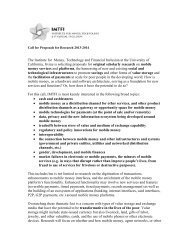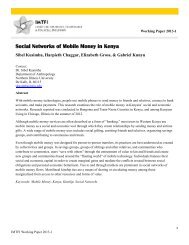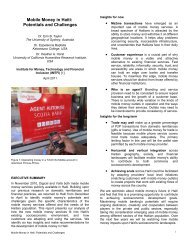How the future shaped the past: The case of the cashless society
How the future shaped the past: The case of the cashless society
How the future shaped the past: The case of the cashless society
Create successful ePaper yourself
Turn your PDF publications into a flip-book with our unique Google optimized e-Paper software.
emained curiously popular, enjoying a new upsurge <strong>of</strong> ubiquity within <strong>the</strong> last few years. 3 We explore its emergence, early conflicts to define <strong>the</strong> concept when trying to apply it by commercial banks. To get a sense <strong>of</strong> <strong>the</strong> power and limitations <strong>of</strong> <strong>the</strong> shared vision as a guide to action we conclude with a brief examination <strong>of</strong> a failed effort by <strong>the</strong> VISA organization to deploy a comprehensive payments product in <strong>the</strong> early 1970s. To talk <strong>of</strong> “shared vision” might seem strange here, as in business <strong>the</strong> word “visionary” is <strong>of</strong>ten reserved for leaders who claim to see what o<strong>the</strong>rs do not and so vision could be seen as something personal ra<strong>the</strong>r than collective. Likewise “vision” might also be understood to by some to imply specificity and precision, although religious visions are <strong>of</strong>ten dreamlike. <strong>The</strong> term that best captures our meaning is “imaginaire” (or “sociotechnical imaginaire”), increasingly used in science and technology studies. <strong>The</strong> imaginaire is imagined new social order understood as <strong>the</strong> natural result <strong>of</strong> adopting an emerging, unproven technology. <strong>The</strong> evolution <strong>of</strong> <strong>the</strong> technology and its mode <strong>of</strong> application are, in turn, re<strong>shaped</strong> by this collective sense <strong>of</strong> <strong>the</strong> <strong>future</strong> as it becomes ingrained, sometimes on a subconscious level, within a community. <strong>The</strong> most striking example, studied by Patrice Filchy, is that <strong>of</strong> <strong>The</strong> Internet Imaginaire. 4Filchy defines <strong>the</strong> imaginaire as a “collective vision” and ties <strong>the</strong> concept closely to utopian thought, arguing that over time a utopian fantasy is transformed though experimentation and <strong>the</strong> application <strong>of</strong> specific technologies into an ideology that directs change in <strong>the</strong> real world. In <strong>the</strong> remainder <strong>of</strong> this paper, and at <strong>the</strong> risk <strong>of</strong> being called pretentious, we <strong>the</strong>refore use <strong>the</strong> term imaginaire ra<strong>the</strong>r than vision. When particular technologies failed to perform as expected this could be characterized as a bump in <strong>the</strong> road to <strong>the</strong> imaginaire, ra<strong>the</strong>r than as a challenge to <strong>the</strong> inevitability <strong>of</strong> eventually arriving at <strong>the</strong> agreed destination. Once consensus on <strong>the</strong> <strong>future</strong> destination was reached a variety <strong>of</strong> specific systems or approaches could be presented as a step toward realizing this <strong>future</strong> goal, making <strong>the</strong> <strong>future</strong> a banner around which a heterogeneous alliance <strong>of</strong> interests could ga<strong>the</strong>r. This, <strong>of</strong> course, would fur<strong>the</strong>r 3








